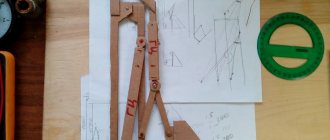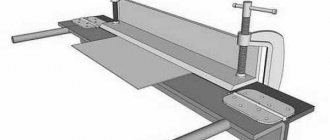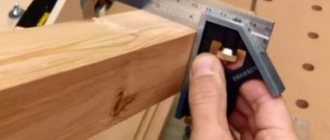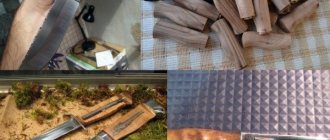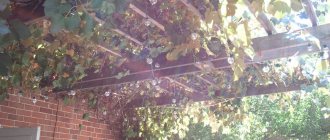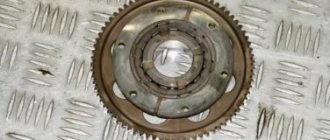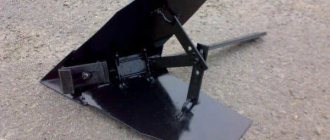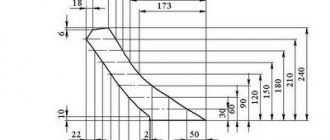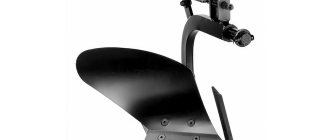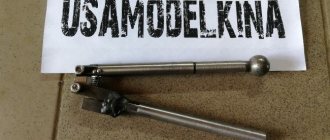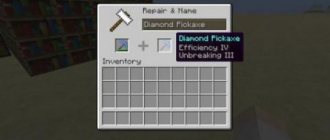Unit types
When making a hitch, the following factors are taken into account:
- tractor power;
- land area;
- model of technology.
Compact models are equipped with a three-point hitch. Before making attachments for tractors, it is recommended to decide on the type of design:
- Plow (for plowing the soil) - rear attachments are used to work with such a unit.
- Harrows (make it easier to plant crops) with a coverage width of 1-2.7 m.
- Potato planter - such a hitch is made for a mini tractor made in Russia, Japan and China (power above 24 hp).
- To care for the crop, rakes are made - the working width of the implement ranges from 1.4-3.1 m. In this case, the engine power must exceed 12 hp. With.
- Cultivator - such a do-it-yourself attachment for a minitractor is made for the purpose of caring for agricultural crops as they grow.
- Sprayer - designed for watering and spraying fertilizer. The productivity of a homemade hitch for a mini tractor is 120 l/1 min.
- Potato digger - designed for harvesting root crops. To connect the unit to the tractor, you will need a rear linkage.
Mini tractor made from a walk-behind tractor
Years passed, capitalism entered the agricultural sector with the confident step of its owner, bringing with it food abundance. The six hundred square haciendas have long become a place of recreation, and agriculture has been taken up by those who should do it - professional farmers. But the issue with agricultural mini-equipment still remained relevant, giving rise to a corresponding proposal - converting walk-behind tractors into tractors, both for yourself and for sale.
A mini tractor made from a walk-behind tractor is no longer an incomprehensible hybrid with a trailer, but a full-fledged vehicle with a frame, suspension, steering, etc. This decision, however, raised new questions for the owners, for example, the issue of using attachments. It became impossible to mount and use attachments for a walk-behind tractor after converting the latter into a tractor.
Having acquired a frame, the improvised tractor began to need other attributes of “real” tractors - such as a hitch on a homemade mini tractor.
Mini tractor hitch
A hitch is a unit used to attach attachments. Some hitch models also provide power transfer from the engine to complex equipment such as a seeder or mower. The hitch must provide reliable fastening of the equipment, but at the same time have sufficient mobility.
As a rule, the mobility of the hitch is ensured in two planes:
- in a horizontal position, to reduce the removal of equipment when taxiing;
- in a vertical position – to transfer equipment from operating to transport state and back.
The rear linkage of a mini tractor made from a walk-behind tractor rarely has a hydraulic drive. Typically, lifting is carried out using electricity through a gear transmission, or by muscular force using a special winch. A manual hitch on a mini tractor from a walk-behind tractor is usually made using a three-point scheme (photo).
Additional designs
Factory and homemade tractors can be used for building roads, loading and unloading materials and performing other work. Such equipment can be equipped with the following designs:
- Bulldozer blade - a lifting mechanism for a mini tractor levels construction sites, removes snow and construction debris. If necessary, a utility brush is installed on the dump.
- Mounted excavator - used when laying communications and constructing a pit.
- Front loader - used in warehouses. If the unit is intended for light-weight equipment, then the homemade hitch on the mini tractor is equipped with counterweights.
Manufacturing of KUN
To assemble a front-end loader for a walk-behind tractor or mini tractor, you will need to prepare drawings. In this case, the carrying capacity of the equipment is taken into account. The walls of the attachments on the minitractor are made of sheet metal (6 mm thick). To do this you will need metal scissors or a gas cutter.
Electric welding is used to secure the sheets together. The service life of attachments for a mini tractor depends on the quality of the seams. The next stage is the manufacture of racks and rods. For this, pipes (diameter 50 and 100 mm) are used. Then the hydraulic booster is installed.
To ensure greater mobility for the last element, the diameter of the bucket should not exceed 30 mm. To secure the racks, a pipe is welded to the front of the equipment. The design is reinforced with metal corners. In order for homemade tractor attachments to rotate, a cylinder is fixed to it.
To make your own bulldozer blade, use a water pipe (section radius more than 70 cm). The width of the device is selected individually in each case. The value of this indicator depends on the technical parameters. Experts advise making a hitch for mini tractors with your own hands from metal 8 mm thick.
To cut the pipe lengthwise, use a grinder. In this case, a distance from the edge is maintained (to ensure optimal bending of the bucket). A metal profile is welded below the center of the pipe. If necessary, do-it-yourself attachment to a minitractor is supplemented with transverse thrust elements.
To attach the blade to the equipment, an A-shaped structure is made. The product is complemented by longitudinal beams. A hydraulic cylinder is used to lower and raise the unit. A bracket is used for its installation. The hydraulic cylinder can be removed from the semi-trailer 2 PTS-4. To secure the blade, you will need a front linkage.
How to make a tractor from a walk-behind tractor with your own hands - drawings. Advantages of a mini tractor
Among the main advantages of a homemade technical product, one should first of all note the lower cost in comparison with ready-made analogues. In addition, such a unit will not require much storage space. Now it’s clear why most owners of personal plots want to know how to make a mini tractor from a walk-behind tractor with their own hands.
At the same time, do not forget about the efficiency of a homemade device, because it does not require a lot of fuel
. The prices for spare parts are also quite attractive and they are easy to acquire. If you install tires with a deep tread on a homemade tractor from a walk-behind tractor, the unit will get good cross-country ability. An equally important characteristic of the device is its small dimensions.
To make a mini tractor with your own hands from a walk-behind tractor, you need to have some knowledge and be familiar with tools.
Before starting work on creating this technical tool, it is worth studying several drawings and reading the relevant literature. Units from various manufacturers have unique technical characteristics, which affects the list of necessary modernization work.
Today on the market you can find models equipped with adapters with a seat. As a result, the process of creating a homemade mini tractor from a walk-behind tractor will be even simpler. However, if the adapter is missing, then making it yourself will not be so difficult. Many owners of personal plots prefer Salyut, Neva and some Chinese models. To make a tractor from a walk-behind tractor with your own hands, in addition to the basic device you will need:
- 2 wheels;
- stainless steel sheet, as well as metal corners and pipes;
- welding machine;
- drill;
- armchair;
attachments.
Plow assembly
Before making the plow yourself, the bend of the plowshare is calculated. The advantages of such a do-it-yourself hitch for a mini tractor include:
- the geometric parameters of the blade and ploughshare coincide with the requirements for cultivating a certain type of soil for a specific agricultural crop;
- making a hitch for a mini tractor with your own hands with maximum efficiency;
- maximum bucket grip;
- long service life;
- the use of various attachments, which allows you to cultivate and plow the soil.
When making your own plow for a mini tractor, special attention is paid to the size and shape of the cutting elements. The efficiency of deepening the structure into the soil and the volume of soil turned over depend on these parameters. When plowing, the plow should not move to the side, bury itself in the ground, or go out. The main parameters of the plow are the angle of the edge plunging into the ground and the bending angle of the blade.
The value of the first indicator determines the nature of the structure’s penetration into the soil and the retention of a given level. Experts advise making a plow with an edge angle of 40°. If the angle is sharp, then the plow will slip out. Otherwise, the unit will not cope with the load.
The angle of the blade depends on the bend of the blade. With the help of large blades, you can cultivate a large volume of land (in 1 pass). When performing such work, a significant load is placed on the tractor. Therefore, experts advise choosing an inclination angle within 25-130 °.
The main load is on the ploughshare. Durable thick steel is used to make the working part of the plow. The shape of the share can be screw, cylindrical or semi-cylindrical. In this case, the value of the bending angle must coincide with the value of the angle of inclination of the blades.
Preparatory stage
Most often a cylindrical plow is made. This mini tractor hitch is used when cultivating various types of soil. The soil is crushed well, but does not penetrate deeply into the formation. Such units are recommended for use on unplowed land during primary cultivation.
Simple plows, unlike the plowshare type, are easy to manufacture. Using the half-screw design, you can turn over the soil without loosening it. The share plow is a durable and reliable attachment for a mini tractor that can be used constantly. The structure processes the ground with cutting elements. The soil is thrown to the sides by two blades. This plow manufacturing technology provides a high level of loosening and depth of soil cultivation.
Read also: How to make a trailer and hitch for a walk-behind tractor with your own hands, Do-it-yourself walk-behind tractor and motor-cultivator
The drawing of the plow is carried out taking into account the type of structure. The single-hull model is presented in the form of a metal pipe of rectangular cross-section. On the opposite side of the product, a cutting element is attached, and on the other side, a wheel and fasteners to the mini tractor.
To process a large area, a two-body hitch for a mini tractor is assembled. The product is made from several frames equipped with different tools. Each component part of the structure performs specific tasks (harrowing, plowing).
If the drawing is completed, then the device is detailed. Then the parts are cut out. To do this you will need a steel sheet and scissors. The shape of the blade depends on the tools used and equipment available. Plate bending machines allow you to achieve high precision.
Step-by-step instruction
If the hitch for a mini tractor is made in a workshop, then you will need a vice and an anvil. A sheet of metal (3 mm thick) is cut out from the finished pattern. Then the parts are bent. When performing this work, maximum accuracy is observed.
To simplify the task, a pipe or cylinder is used. The lower part of the blade and the cutting element are reinforced with metal tape (5 mm thick). To fix it, use secret rivets or a welding machine. Then the surface is cleaned. A holder is welded on the opposite side (length up to 40 cm). To cultivate the soil at different depths, it is recommended to equip 3-4 holes in the holder.
A rectangular steel pipe is used to make the body. The length of the body should vary between 0.5-1 m (taking into account the amount of hanging structure). A flange is mounted on one side of the pipe (to secure the frame to the equipment). On the opposite side, the working part of the plow is mounted on bolts.
If a heavy plow is being manufactured, then the installation of two wheels is provided. They are positioned relative to the axis line so as to ensure balance of the plow during operation and reduce the load on the mini tractor.
When operating any attachment for a mini tractor, it is recommended to follow safety precautions.
Overview of attachments
Compact tractors are used in almost all sectors of agriculture. Many attachment devices are designed specifically for soil cultivation. There are various devices for cultivating soil, caring for plants and farm animals.
Attachments for a mini tractor
Note! To install front and other attachments on the tractor, use a mechanical three-point hitch on a mini tractor.
Planting devices
The plow is the most important tool for preparing the soil for spring field work. The compact tractor can work with equipment of different designs. If the farm has equipment with a power of up to 30 horsepower, then single- or double-body tools are used. The plowing depth of such units is from 20 to 25 cm (this indicator can be changed very easily).
If a mini-tractor like UAZ or Ural has a motor of more than 35 horsepower, then a four-wheeled plow is connected to the tractor. With its help it is possible to significantly increase the plowing depth. These systems are most often used by summer residents and small farms.
Disc plows and homemade plows are used for uncultivated and dense soil types. Large farming enterprises use manual and rotary models.
Attention! All plows are attached to the tractor through the rear linkage, not through the front linkage.
Before planting, the soil must be carefully prepared. This can be done by using a harrow. Depending on the design, they weigh from 200 to 650 kg. The width of soil gripping by shovels in such structures is from 1 to 2.7 m. Some models are capable of cultivating soil at a depth of up to 15 cm, sufficient for effective soil treatment.
Milling cutters are a type of plow. They are used in a small area. They are most suitable for those areas where the soil is regularly and efficiently cultivated. For areas that have not been plowed for a long time, a large plow is suitable.
Planting equipment
This type of equipment includes potato planters. There are several models of planters, with 1 and 2 rows. They also have different tank sizes for planting tubers. Different agricultural enterprises and individual owners can choose tanks of various sizes.
Homemade potato planters for mini tractors are a universal unit. They cut a furrow and throw out planting material, that is, potato tubers, at an equal distance. After this, the planting is automatically covered with soil. All these operations are performed while the mini-tractor is moving around the site. If it stands, then planting potatoes is impossible.
The power of the planters is from 24 horsepower and more. Weight – about 180 kg.
Important! The potato planter should only be used on farms with a large area. The use of attachments in summer cottages and garden plots is ineffective and impractical.
Hiller is equipment for covering the planting site of agricultural crops with soil. Plants are processed in rows. Works the same as a seeder.
Plant maintenance equipment
It is advisable to use it for selecting and collecting hay into windrows, raking hay and debris, and tedding. A rake is used for all these purposes. There are a large number of modifications of rakes for mini-tractors, depending on the power of the tractor and the amount of work required.
Cultivators are used to clear fields of weeds. They loosen the soil well and remove roots. It is advisable to use the equipment when the plants are small, immediately after the seeds germinate.
Using mounted sprayers you can control plant pests. For summer cottages, use universal models of sprayers. They consume less fuel and provide processing of a large area of land.
Read also: Miracle shovel: reviews
Homemade rotary mowers for mini tractors allow you to effectively mow plants. Homemade mini tractors with coon are used for more efficient operation of the hay loader.
Harvesting equipment
This includes potato diggers. The most popular types of diggers in homesteads and farming are vibrating and conveyor ones. If a farmer has a homemade mini tractor, then most often they make their own digger.
Note! The easiest digger to install is the fan type.
Drum and horse-drawn diggers and hay mowers are also on sale.
Homemade attachments
When the finished mini-tractor has passed all the tests, acquired the status of significance and earned the love of the entire family, the task of manufacturing attachments for it comes to the fore. And this depends on the intended crops and soil cultivation. If a walk-behind tractor was used to create a tractor, then there is a ready-made unit for coupling with agricultural implements. Otherwise, you will have to make a canopy with your own hands, a photo of which is presented.
It shows that the hitch has a three-point design. It must be movable both vertically and horizontally. Made from steel profiles using a welding machine. Needed for connecting units.
Of course, it is possible to make a single-point hitch unit, but this will greatly reduce the number of mounted agricultural machines and, consequently, reduce the versatility of the tractor.
There are several types of agricultural implements for cultivating land.
Types of plows
For homemade tractors, the following types of plows are most often used: single-body and double-body. The former cling to light and medium-sized walk-behind tractors, while the latter cling to more substantial equipment. For a mini-tractor, if it has a powerful engine and decent weight, multi-body moldboard plows are prepared, which are attached to a homemade hitch.
The plow is often made from the skimmer of a factory plow, which is usually used by the MTZ tractor. It is only necessary to slightly modify the plowshare and the correct bend of the blade. It is possible to use a horse plow.
For plowing heavy and hard soils, as well as soils with roots of trees and shrubs, homemade disc plows are used. They are a frame with sharp disks with a diameter of up to 40 cm, which cut into the soil at a slight angle relative to the direction of movement. This allows them not only to cut the roots, but also to loosen the soil.
Hillers and harrows
Any homemade hiller consists of a frame and two disks located at an angle to each other. This unit is used for hilling rows of potatoes and strawberries.
Harrows are designed to break up clods and loosen plowed soil. They consist of a lattice frame measuring 100x50 cm, welded from 50x50 mm corners, and sharp fingers up to 15 cm long, spaced evenly over the frame area. The harrows hitch behind the plow and work together with it.
Potato planters and diggers
This mounted trailed equipment is used for a specific crop – potatoes. It is powered by its own wheels, which allows the seeds to be evenly distributed along the furrow and does not depend on slippage.
A potato digger is a sharp knife 20-30 cm wide, which goes horizontally into the soil to a depth of 20-25 cm. Using an inclined grid, it pulls the potatoes to the surface. At the same time, the tubers are cleansed from soil and grass.
Other equipment
Depending on the purpose, other attachments can be used:
- Mounted mowers. They are used for making hay for domestic animals and removing weeds in the garden.
- Rake for raking up grass clippings. They are mounted and trailed. Trailed ones have two wheels. Hitches directly to the tractor.
- Mounted cultivators. They usually consist of a frame and 6-8 cultivator tines. The operating principle is similar to that of a flat-cut plow. They have two wheels with which the depth of cultivation can be adjusted.
- Garden sprayers. This is the required unit. They spray cultivated crops to protect them from pests, and also protect grains from weeds using special chemical compounds. Mainly used in farmers' fields.
- Bulldozer blades. They are hitched in front or behind the tractor. They are a shovel up to 1.5 m wide. They are made of steel 3-5 mm thick. Attached using a hinged device. Designed for clearing the area of snow and debris, as well as for leveling the surface of the site.
- Coons. This special device is used only for loading and unloading operations. Manufactured for a specific type of mini-tractor activity.
- Rotary brushes and snow blowers. They are especially necessary in winter on city streets. A tractor with such equipment is able to clear all the bottlenecks between houses and shops where it is difficult for an ordinary tractor to reach.
Assembling a simple unit, as well as homemade attachments for a mini-tractor, does not present any particular problems. All you need is time, desire, the necessary tools and materials.
Types of attachments
A do-it-yourself hitch for a minitractor is made from a steel profile. The best manufacturing method is welding. There should be equipment for connecting any working equipment.
The most commonly used is a three-point nozzle. It provides easy movement of equipment in various geometric planes. Almost all farm equipment is designed to accept three-point attachments.
Three-point hitch for a mini tractor
The exception is the mini-tractor, which has a caterpillar track. For such a unit, a universal nozzle is usually used, which, if necessary, can easily be transformed into a two-point one.
How to make a tractor from a walk-behind tractor with your own hands. Application area
This machine will be extremely useful in agriculture, because it can be used to do a wide range of work, for example, clearing snow using a mini tractor. Therefore, even old walk-behind tractors can be very successfully used to create mini tractors that will be more than useful to you.
You can do this from a new walk-behind tractor if you think you need a compact tractor more.
In agriculture, technology plays a very important role. She is both a method of transportation, and an excellent assistant, and a tractor, and a strongman. Therefore, there is nothing better than a private house with a farm, which has a full fleet of all necessary equipment. Tractors are especially widely used (for example, MTZ tractors).
Mini tractor
They do not have to be large and powerful, because even a small and compact tractor can provide significant assistance and become a good transport and way of transporting goods. In a word, there can be as many applications for such equipment as are convenient, because when working on the ground, you can come up with almost any “tasks.”
But small tractors are most often used precisely as transport, as well as mobile platforms on which various agricultural equipment can be installed.
If you equip a minitractor with a bucket, you will get an analogue of an excavator (see, for example, a Hyundai excavator), with which you can dig and loosen the ground, which is simply necessary in agriculture.
In addition, with a mini-tractor you can even graze livestock comfortably, because instead of walking, you will be riding on your steel horse.
Is it possible to make a mini tractor yourself? If you have no idea how to make a mini tractor from a walk-behind tractor with your own hands, then we are ready to please you: everything is easier than it seems. To get inspired, you can look at how to make a mini tractor from a walk-behind tractor with your own hands
Breaking and remaking equipment is not the most difficult process. Plus, you don't have to do absolutely everything yourself. There are special kits that will allow you to easily transform one type of equipment into another in a short period of time. This set includes the following parts:
Frame
- Frame with special mounting space for engine
- Pedals
- Seats
- Levers for disabling the axle shaft locking
- Steering wheel
- Wings
- Front beam and rear linkage
This kit is ideal for those who are wondering how to quickly convert a walk-behind tractor into a mini tractor. But there are many people who approach this idea with genuine enthusiasm, and therefore want to carry out all the work themselves, without using ready-made sets of parts.
It is for them that we will tell you how to make a mini tractor yourself from a walk-behind tractor.
Manufacturing of attachments
Buying canopies for a walk-behind tractor will be very inconvenient for a small summer resident. A summer resident or farmer can make all the equipment himself at home, using a little ingenuity. Most of the equipment is quite simple and can be made from almost whatever is on hand.
Before you make a plow for a mini tractor with your own hands, you need to carefully study the drawings and dimensions and choose the most optimal one. It will be easier to make equipment if you have a ready-made factory circuit.
Making a hiller
To do this, you need to take 2 metal disks with a thickness of 2 mm and position them so that they open outward. When the angle is selected, they are secured with bolts or simply welded. Then it is simply secured to the hitch.
Potato planter
The structure of this unit resembles a hiller. It has a bowl on top into which potato tubers are poured. From a special hole they fall into the ground.
To make a homemade potato planter, you need to assemble wheels, an axle, pins, a hopper, sprockets, and an adjustment mechanism. All this is attached to the frame.
The wheels are covered with a metal plate at the front, otherwise the potatoes will fall out of the hopper at times when this is not needed. The bottom of the hopper is covered with rubber so that the potatoes do not fall out.
How to make a bucket for a mini tractor? For this you need tin and internal racks. 2 side and internal racks form a bucket. The rods are screwed to them.
Mills, plow
This is one of the most important equipment. Milling cutters are used for processing soft and constantly cultivated soil. A homemade plow for a mini tractor is more suitable for working with hard soils. To make a homemade plow, you need to take a plate with a thickness of 3 to 5 mm and a pipe with five-millimeter walls.
The plate is sharpened with a knife, like a scythe. Next, the blade is turned out using a grinder. The cutting part is the working element of the scythe, which is beaten on the anvil.
Milling cutters are used for processing soft and constantly cultivated soil
All parts are glued together with obligatory observance of corners. The ploughshare is placed on a steel sheet. These elements must be spot welded on both sides.
Important! The ploughshare and shaft must be joined very tightly. There should be no gaps between them.
Making a trailer adapter
The design of this device includes:
- metal frame;
- hitch;
- cross bar;
- braces;
- racks, axle, wheels;
- management tools;
- trailer or cart;
- space for the operator and connection of additional mechanisms.
The frame is made of pipe (length - from 1.5 to 1.7 m). A hitch is welded at one end and a rod at the other. Wheel racks and a brace are attached to the rod.
Levers are used to control devices. By switching them, you can set the optimal position of the attachment. An additional lever is installed to adjust the applied force.
The length of the drawbar depends on the power of the walk-behind tractor. Engine power affects wheel size. Additionally, hydraulics are installed.
The hitch for an internal combustion engine mini tractor and other units can be easily done independently. It fits almost all agricultural equipment, greatly facilitates and reduces the cost of all work in the country or on the farm. Proper use of the equipment extends the service life of the walk-behind tractor.
Factory Attachments
There is a wide selection of equipment for mini tractors on the market, for example:
- Double-furrow plows 1L-220, 1L-225, 1L-230. They are used in conjunction with tractors with a power of 12, 25 and 30 l/s and manual drive. The average cost of such a plow is from 10,500 to 20,000 rubles.
- Disc harrows 1BQX 1.1, 1BQX 1.9, BT-4. Necessary for preparing the soil for planting. Price - from 30,000 rubles.
- Potato planters UB-2 and DtZ-2.1. Suitable for units with engine power from 24 horsepower.
- Tedding rake 9 GL and 3. 1G. Suitable for cars with engine power from 12 horsepower.
Factory additional equipment also includes a front loader, mounted sprayers SW-300, SW-400 and SW-800, etc.
General overview of factory-made equipment
Mini tractors work in all industries, but they are most in demand in agriculture. The manufacturer takes this into account, so most attachment mechanisms are designed for soil treatment, caring for animals and vegetation, as well as performing planting and harvesting work. To connect most equipment, a three-point hitch is installed on a mini-tractor, but there is also a two-point option.
Equipment for preparing soil for planting work
The plow is responsible for preparing the soil. A mini-tractor operates with attachments of various designs. Single- and double-furrow plows are used with equipment with a power of up to 30 hp. With. Their plowing depth is adjustable from 20 to 25 cm. If the unit is equipped with a motor of more than 35 liters. pp., then you can hook up a four-furrow plow, for example, model 1L-420. The plowing depth has already increased to 27 cm. Such models are called reversible or plowshare-moldboard and are most often used by private owners for their summer cottages.
There are also disc plows used for heavy soils and virgin lands. On farms, soil preparation can be carried out using rotary models.
Read also: Vortex blowers: operating principle and features
Before planting, the soil needs to be prepared. Disc harrows are responsible for this area of work. Depending on the design, their weight is in the range of 200–650 kg, and the soil working width is from 1 to 2.7 m. Different models differ in the number of discs, as well as the harrowing depth. For example, 1BQX 1.1 or BT-4 cultivate soil up to 15 cm deep.
Planting equipment
This type of trailed mechanism includes potato planters. There are single- and double-row models with different tank volumes for planting tubers. The potato planter itself cuts a furrow, throws the potatoes at an equal distance, and then rake them in with soil. All this is done while the mini-tractor is moving across the field. As an example, we can take the UB-2 and DtZ-2.1 models. The planters are suitable for domestic and Japanese equipment with a power of 24 hp or more. With. The equipment weighs around 180 kg.
Plant maintenance equipment
For tedding and raking hay into windrows, a rake is attached to the mini-tractor. Such equipment is more in demand by farmers and private owners who have large areas allocated for haymaking. Tedding rakes are produced in various modifications. For a mini-tractor with a power of 12 hp or more. model 9 GL or 3. 1G is suitable. The equipment is characterized by a swath width of 1.4–3.1 m and a weight of 22 to 60 kg.
Cultivators clear the field of weeds, loosen the soil, and remove the roots of unnecessary vegetation. The equipment is used after the plantings emerge and during the entire period of their growth. Common models include KU-3-70 and KU-3.0.
Mounted sprayers help control crop pests in fields and gardens. Models SW-300 and SW-800, produced by a Polish manufacturer, are universal. The equipment is suitable for all models of mini-tractors. With a liquid solution flow rate of 120 l/min, the jet covers up to 14 m of the treated area.
Harvest equipment
This type of equipment includes potato diggers. Conveyor and vibration models are mainly used. For a homemade mini-tractor, the diggers are often made independently. The easiest to manufacture is the fan design. There are also drum-type and horse-mounted diggers. Factory-made models include DtZ-1 and WB-235. Any potato digger is connected to the rear linkage of the tractor.
Other types of factory-made equipment
This category includes mechanisms that are rarely used in the agricultural industry. Most often they are in demand at construction sites, as well as by public utilities.
The blade is connected to the front linkage of the tractor. It is needed to level the soil and clear the area of debris and snow. When cleaning roads, the blade is usually used in conjunction with a rotary brush attached to the rear linkage of a mini tractor.
A bucket is a kind of mounted excavator on a mini-tractor, which is designed to perform earth-moving work. A small bucket is convenient for digging trenches for laying communications or small pits. The mounted excavator has its own hydraulic distributor. To connect to a mini-tractor you need a three-point hitch.
A front-end loader, or KUN in other words, is often used in warehouses and granaries. From the name it is already clear that the mechanism was created to perform loading operations. To prevent a light tractor from overturning under the weight of a loaded KUN, a counterweight is attached to the rear linkage.
The price of factory-made equipment is quite high. It all depends on the manufacturer, model and other factors. Let’s say the cost of a plow varies from 2.4 to 36 thousand rubles. A harrow will cost from 16 to 60 thousand rubles, and potato planters from 15 to 32 thousand rubles. Such high cost encourages enterprising private owners to make the necessary devices with their own hands. The easiest way is to make a homemade hitch, which we will talk about now.
Factory Attachments
There is a wide selection of equipment for mini tractors on the market, for example:
- Double-furrow plows 1L-220, 1L-225, 1L-230. They are used in conjunction with tractors with a power of 12, 25 and 30 l/s and manual drive. The average cost of such a plow is from 10,500 to 20,000 rubles.
- Disc harrows 1BQX 1.1, 1BQX 1.9, BT-4. Necessary for preparing the soil for planting. Price - from 30,000 rubles.
- Potato planters UB-2 and DtZ-2.1. Suitable for units with engine power from 24 horsepower.
- Tedding rake 9 GL and 3. 1G. Suitable for cars with engine power from 12 horsepower.
Factory additional equipment also includes a front loader, mounted sprayers SW-300, SW-400 and SW-800, etc.
Types of attachments and independent production of a three-point structure
A do-it-yourself attachment for a mini-tractor is made from a steel profile by welding. But before you do this, you need to understand the essence of the design. The hitch is needed to connect the working equipment of the tractor. There are models of seeders and mowers for which the linkage ensures transmission of motor power.
The three-point hitch is made movable in two planes: vertically and horizontally. The hydraulic drive is usually installed only on the front linkage. Now let's talk about the design. Almost all agricultural equipment is connected to a three-point hitch. An exception may be a mini-tractor with caterpillar tracks or with a broken frame. Such equipment can have a universal hitch, which, when working with a plow, transforms and becomes a two-point one.
The three-point homemade hitch is a triangle welded from a steel profile. The mobility of the connection with the tractor is ensured by a central screw. An example of a homemade hitch can be seen in the photo.
How to properly convert a walk-behind tractor into a tractor?
To successfully assemble a homemade tractor from a walk-behind tractor with your own hands, you need to clearly know what is needed for this and how to do everything correctly. Therefore, before starting work, you need to draw up a detailed transformation diagram and draw drawings of the assembled components and assemblies (or borrow them from friends who have already done such work before). And only after thoroughly understanding the diagram and drawings can you begin work on the actual alteration.
Frame
To make a 4-wheel tractor with your own hands from a 2-wheel walk-behind tractor, the first thing you need to do is make a frame. Depending on the purpose of the future tractor, the frame can be:
- Solid, if the tractor is needed primarily for agricultural work;
- Breaking if the tractor often has to move through hard-to-reach places.
It is best to make the frame with a rear adapter so that you can attach a trailer or other attachments to a homemade tractor.
First, the dimensions of the future frame are determined, then the blanks of the required size are cut and connected into a single structure by welding or bolts. For greater strength, you can install an additional cross beam on the frame.
When making the frame, you must not forget to mount a hitch on it for aggregation with attachments. It can be mounted either front or rear. Also, be sure to remember to weld the towbar at the back, otherwise it will be impossible to attach a trailer to the minitractor.
To make a homemade frame, you need to use a grinder to cut blanks of the appropriate size from steel pipes and sheets, and then weld them into a single structure. For greater reliability, an additional transverse steel beam can be welded in the middle of the frame.
Wheels
Having finished with the frame, we move on to installing the wheels. To install them, you will need two hubs with brakes and a piece of metal pipe that is the width of the front axle. A through hole is made in the center of the pipe, through which it is attached to the front frame, and wheel hubs are attached to its sides. Then the steering rods are mounted, the worm gear is secured and the steering column is installed.
To transmit torque from the engine to the rear axle, mounted on bearings pressed into the bushings, a pulley is installed. Wheels from a passenger car are mounted on both axles, or you need to purchase another pair for the 2 “original” wheels of a walk-behind tractor.
First, the front and rear axles are attached to the frame, on which the wheels are mounted. Usually, the “original” wheels of a walk-behind tractor are left on the rear axle, and wheels from a passenger car are put on the front axle, although it is also possible from other agricultural equipment.
Engine
The engine is mounted at the front in order to maintain the desired balance of the structure when mounted with trailed equipment. But the power take-off shaft in the homemade product is located on the rear axle of the mini tractor. It is driven through a belt drive. At the final stage of assembly, the brakes and hydraulic distributor are installed.
Then all other important components and assemblies are attached to the frame: steering wheel, transmission, pedals, brake, operator’s seat, etc. If desired, you can install headlights and side lights, as well as a sun canopy.
